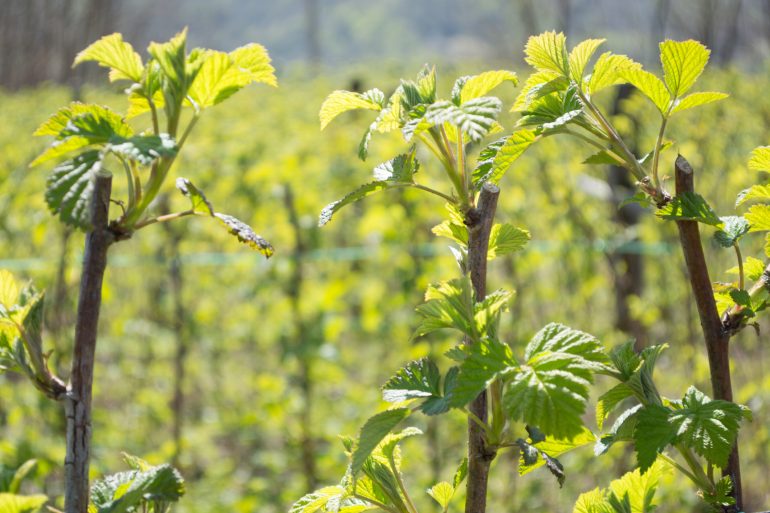Whether you’re eating them raw, or you’re making jam, crumbles, ice-cream, yoghurt or muffins, raspberries have that unmistakable tang when you bite into them. And their flavour is matched by their fortifying powers. Because these little fab fruits are a great source of vitamins and antioxidants.
That, along with the fact that you’ve got no plastic packaging or air miles to deal with make raspberries a great fruit to grow yourself, so without further ado, let’s discover how to grow raspberries in the UK.
The UK’s Most Popular Raspberry Varieties

Sweet All Gold rasperries (Credit: Henadzi Pechan via Getty Images)
Before we get to the details of just how and when to plant raspberries in the UK, let’s look at the different types. There are quite a few to choose from, and your choice, including summer-fruiting and autumn-fruiting varieties, impacts everything from size and colour of the berries to the yield and the plant’s resilience.
The UK’s climate is well-suited for raspberry cultivation, and choosing the right variety is key to a successful harvest. Among the most popular early and mid-summer varieties are Glen Moy, Malling Jewel, Tulameen, and Glen Ample, and some of the most frequently-grown autumn varieties include Autumn Bliss, Joan J, and a beautifully sweet yellow raspberry called All Gold.
How To Grow Raspberries UK

Just a few of the 800,000 tonnes of raspberries grown each year (Credit: Yevgen Romanenko via Getty Images)
While over 800,000 tonnes are harvested every year around the world, it’s much better to grow them at home! You can grow raspberries in containers, but the best method is to plant raspberry canes. Let’s dig further into how and when to plant raspberry canes in the UK.
When To Plant Raspberries in the UK

Raspberry twigs ready to fruit (Credit: radebg via Getty Images)
Timing and planting conditions are important to establish healthy raspberry plants. The best time to plant raspberry canes is between November and March when the plants are dormant, provided the ground isn’t frozen or waterlogged.
Planting Raspberries

Planting raspberries (Credit: Tatka_Go via Getty Images)
Planting raspberries properly is essential for healthy growth and a plentiful harvest, and the first step on the journey of how to grow raspberries in the UK is choosing the right planting site and preparing the soil.
Choose a sunny spot with well-drained, fertile soil. Ensure the soil is rich in organic matter and has a slightly acidic pH between 5.5 and 6.5. Next, clear the area of weeds and debris and dig in compost or well-rotted manure.
Space your raspberry plants around 45 – 60 cm (18 – 24 inches) apart within rows, and make sure the rows are between 1.5 metres and 1.8 metres (5 – 6 feet) apart to allow the roots to grow, for good air circulation and to reduce the risk of disease. Fill the holes with soil, cover with mulch to conserve moisture and suppress weed growth, and press down gently. Lastly, water each plant well to settle the soil.
Support Structures
Supports are important, especially for summer-fruiting raspberry varieties. Put up posts about two metres (6.5 feet) high at each end of the row and stretch galvanised wires horizontally at heights of 75 cm (2.5 feet), 1.05 metres (3.5 feet), and 1.35 metres (4.5 feet) and tie the canes to them as they grow. This helps to manage the canes and makes harvesting easier.
Some canes will be pre-pruned, but if not, cut the canes back to 25 cm (10 inches) above ground level after planting. This encourages strong new shoots to develop.
By following these spacing and planting guidelines, your raspberries will have plenty of room to grow and get the nutrients they need, hopefully leading to healthy plants and a great crop of sweet berries. Proper spacing also allows for easier maintenance and harvesting during the growing season.
How To Prune Autumn Raspberries UK

Pruning raspberry plants (Credit: PavelRodimov via Getty Images)
For autumn-fruiting raspberries, pruning is done in late winter, typically between February and early March when all the canes should be cut back to ground level. Pruning in late winter encourages the growth of strong, new shoots that will produce fruit in the upcoming season. This ensures a healthy plant and optimises fruit production from late summer through to autumn.
Cultivation, Care & Pest Protection

Raspberry plants protected by a net (Credit: Philippe Gerber via Getty Images)
Aftercare is as important as knowing when to plant raspberry canes in the UK. Once established, your raspberry plants need consistent cultivation and care, including regular watering to swell the fruit, mulching to conserve moisture, and feeding with a balanced fertiliser to promote healthy growth. Pest protection is also vital, as common pests like raspberry beetles and aphids can affect the plants.
Birds and squirrels love raspberries, so you may want to protect your plants with a cage or netting.
Harvesting

Picking raspberries (Credit: Daisy-Daisy via Getty Images)
A general rule of thumb is that your raspberries are ready to harvest when they can be taken off the plant with a gentle pull. Your early summer varieties will be ready from around mid-June, and later summer plants will ripen into early September. Autumn raspberries are usually ready from mid- to late-August and can carry on until the first frosts.
One good tip is to pick your berries on a dry day because moisture can encourage mould growth. They’ll keep in the fridge for a few days but they freeze well straight from the plant.
Wrapping Up

Bon appetit! (Credit: igorr1 via Getty Images)
So, we’ve explored each step of how to grow raspberries in the UK. Along the way, we’ve answered questions regarding where and when to plant raspberries in the UK as well as their upkeep and care, such as when to prune autumn raspberries. We hope you’ve found it fruitful.












